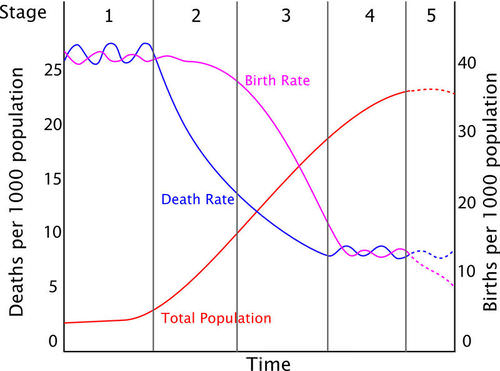6.22 人口过渡
章节大纲
-
What you will learn
::你会学到什么-
What is demographic transition
::何为人口结构转型 -
Stages of the demographic transition
::人口结构转型的各个阶段
Do populations continuously grow?
::人口是否持续增长?Not necessarily. The growth of a depends on a number of issues. Obviously, the average age of the individuals of that population is important. But other factors, such as the local economy, also play a role.
::一个人的增长不一定取决于若干问题,显然,该人口的个人的平均年龄很重要,但其他因素,如当地经济,也起着一定的作用。Demographic Transition
::人口人口结构过渡Major changes in the first began during the 1700s in Europe and North America. First, death rates fell, followed somewhat later by birth rates.
::欧洲和北美从1700年代开始发生第一次重大变化,第一,死亡率下降,随后是出生率。Death Rates Fall
::死亡率下降Several advances in science and technology led to lower death rates in 18 th century Europe and North America:
::在18世纪的欧洲和北美,科学和技术方面的一些进步导致死亡率降低:-
New scientific knowledge of the causes of disease led to improved
supplies, sewers, and personal hygiene.
::关于疾病原因的新科学知识导致供应、下水道和个人卫生得到改善。 -
Better farming techniques and machines increased the
food
supply.
::更好的耕作技术和机械增加了粮食供应。 -
The Industrial Revolution of the 1800s led to new sources of
energy
, such as coal and electricity. This increased the efficiency of the new agricultural machines. It also led to train transport, which improved the distribution of food.
::1800年代的工业革命带来了新的能源,如煤炭和电力,提高了新农业机械的效率,还带动了运输培训,改善了粮食分配。
For all these reasons, death rates fell, especially in children. This allowed many more children to survive to , so birth rates increased. As the gap between birth and death rates widened, the human population grew faster.
::由于所有这些原因,死亡率下降,特别是儿童死亡率下降,这使更多的儿童得以存活下来,因此出生率上升,随着出生率和死亡率差距扩大,人口增长速度加快。Birth Rates Fall
::出生率下降It wasn’t long before birth rates started to fall as well in Europe and North America. People started having fewer children because large families were no longer beneficial for several reasons.
::早在欧洲和北美的出生率开始下降之前,人们就开始少生孩子了,因为由于几个原因,大家庭不再有益。-
As child death rates fell and machines did more work, farming families no longer needed to have as many children to work in the fields.
::随着儿童死亡率下降,机器工作增加,农业家庭不再需要多少儿童到田里工作。 -
Laws were passed that required children to go to school. Therefore, they could no longer work and contribute to their own support. They became a drain on the family’s income.
::法律的通过要求儿童上学,因此,他们不能再工作,不能为自己的支助作出贡献,他们成了家庭收入的消耗品。
Eventually, birth rates fell to match death rates. As a result, slowed to nearly zero.
::最终,出生率下降到与死亡率相符的水平,因此,降低到接近零。Stages of the Demographic Transition
::人口过渡的各个阶段These changes in population that occurred in Europe and North America have been called the demographic transition . The transition can be summarized in the following four stages, which are illustrated in the Figure :
::在欧洲和北美发生的这些人口变化被称为人口结构转型。-
Stage 1—High birth and death rates lead to slow population growth.
::第一阶段——高出生率和高死亡率导致人口增长缓慢。 -
Stage 2—The death rate falls, but the birth rate remains high, leading to faster population growth.
::第二阶段——死亡率下降,但出生率仍然很高,导致人口增长速度加快。 -
Stage 3—The birth rate starts to fall, so population growth starts to slow.
::第三阶段——出生率开始下降,因此人口增长开始放缓。 -
Stage 4—The birth rate reaches the same low level as the death rate, so population growth slows to zero.
::第四阶段——出生率达到与死亡率相同的低水平,因此人口增长放慢到零。
Stages of the Demographic Transition. In the demographic transition, the death rate falls first. After a lag, the birth rate also falls. How do these changes affect the rate of population growth over time?
Summary
::摘要-
Major changes in the human population first began during the 1700s. This occurred in Europe and North America.
::人类人口发生重大变化始于1700年代,发生于欧洲和北美。 -
First, death rates fell while birth rates remained high. This led to rapid population growth.
::首先,死亡率下降,而出生率仍然很高,导致人口迅速增长。 -
Later, birth rates also fell. As a result, population growth slowed.
::后来,出生率也有所下降,因此人口增长放缓。
Review
::回顾-
How did science and technology affect the human population?
::科学和技术对人类的影响如何? -
List two important scientific changes that affected the human growth rate.
::列出了影响人类增长率的两种重要的科学变化。 -
Outline the four stages of the demographic transition as it occurred in Europe and North America.
::概述欧洲和北美人口结构转型的四个阶段。
-
What is demographic transition

